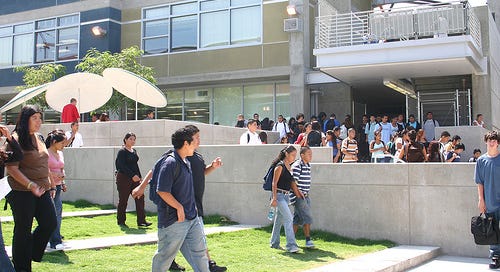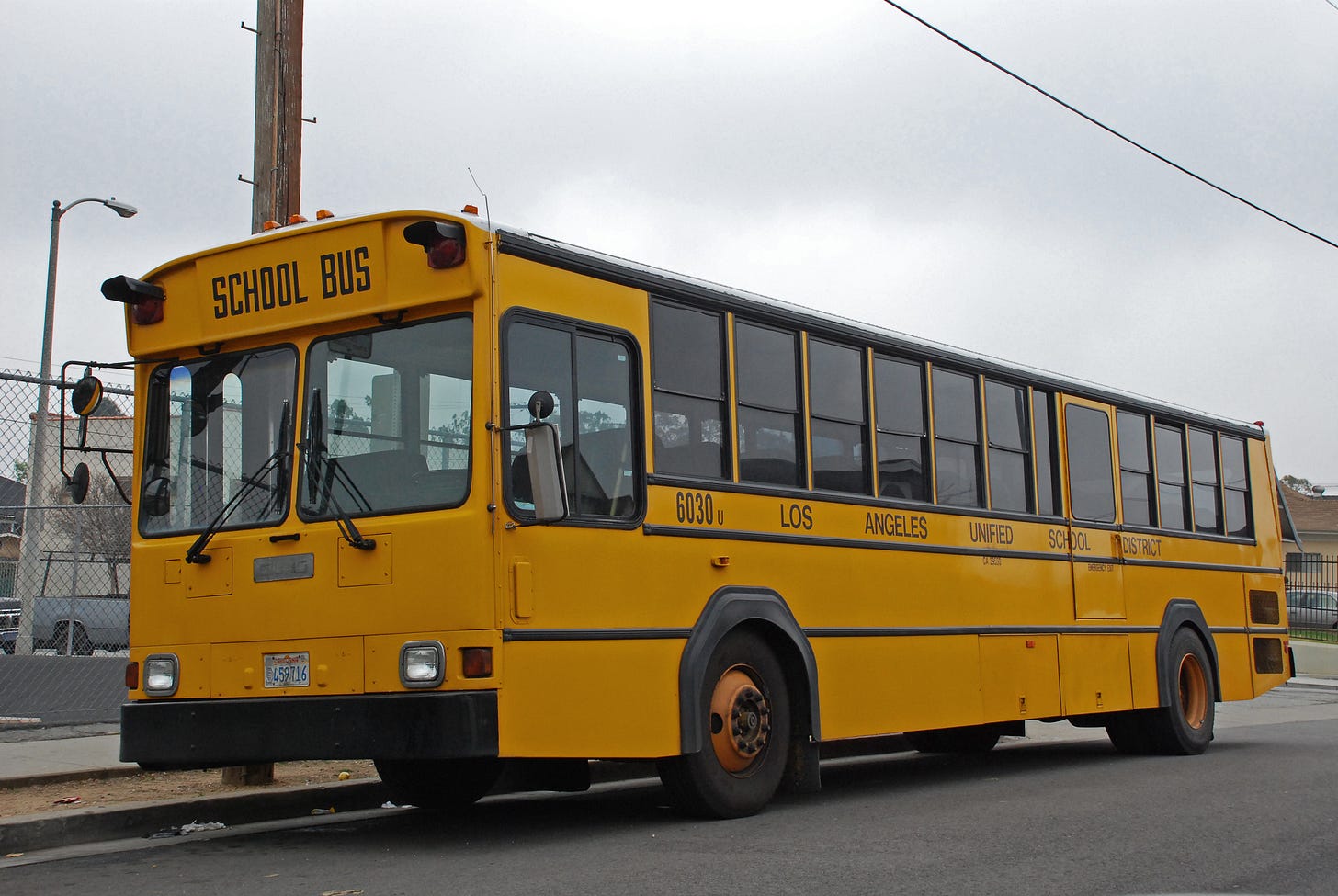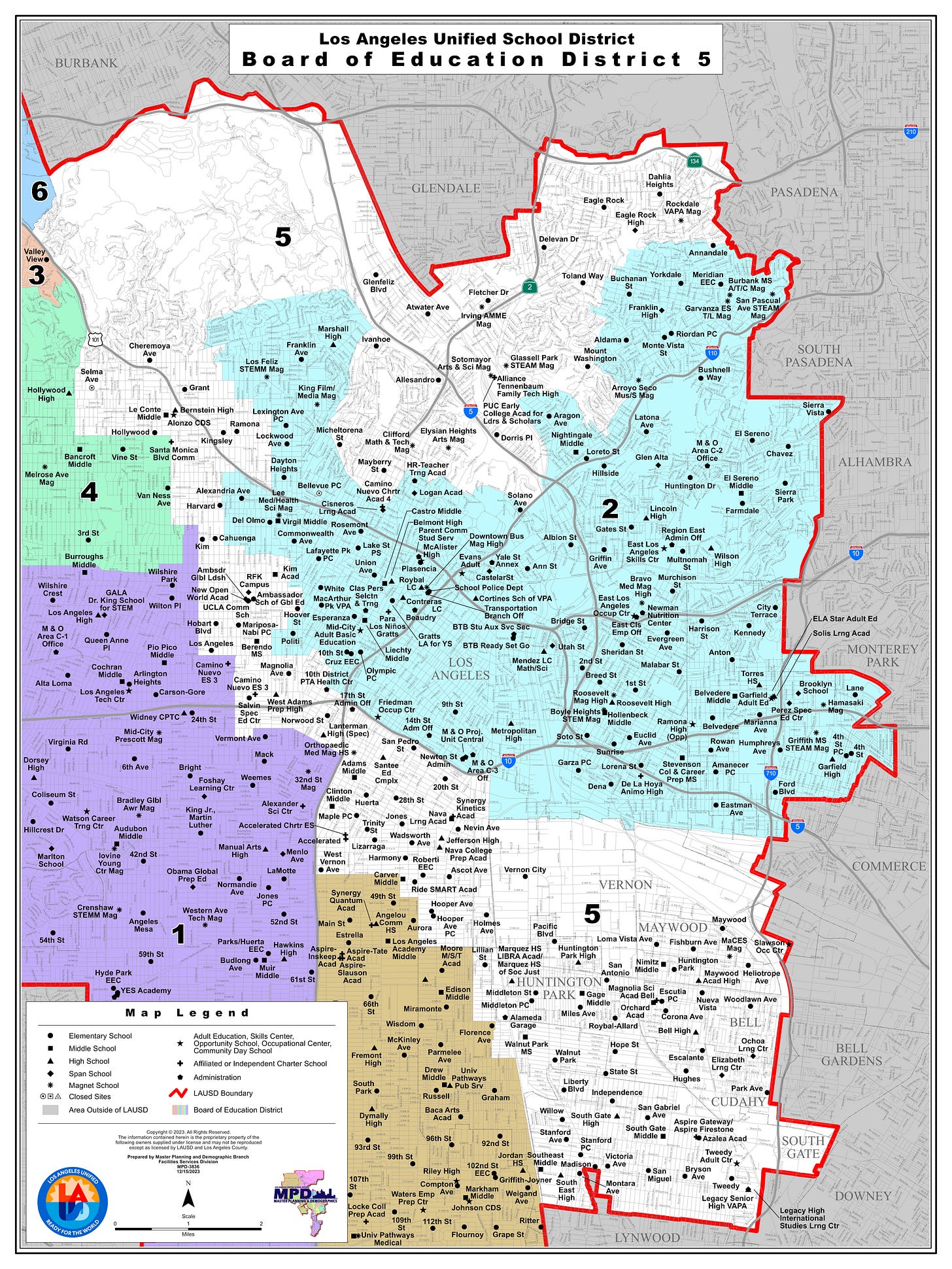Use this cheat-sheet for LAUSD Elections this March
A brief overview of school board candidates to watch heading into February 2024
Editor’s Note: This week was devastating for L.A. Media due to the mass layoffs at the L.A. Times announced on Tuesday, January 23rd. Our hearts go out to all those affected, most of all to writers, editors, and other staffers of color, as well as the communities they’ve served.
With L.A. City Council races out of the way, let’s place LAUSD elections for this March into perspective. LAUSD has a board of seven members, each of which is elected every four years. The board meets regularly on Tuesday afternoons, and by a long shot, the most important job of the board is managing the Los Angeles Unified School District budget, which in the 2023 - 2024 fiscal year is nearly $19 billion dollars for L.A.’s schools.
In more ways than one, the school board in its current form is a relic of L.A.’s 20th century political structure that’s hanging on just by a thread here in the 21st. Yet even in the 1960s and 1970s, when six at-large representatives oversaw services for approximately 100,000 students each, they maintained some of the most segregated schools in the nation and were notoriously overwhelmed by student and community outrage over separate and unequal systems, as demonstrated by L.A.’s 1968 Chicano Walkouts.
But while the city and the county of Los Angeles have nearly doubled in population since the 1960s, LAUSD has continually decreased in enrollment, most recently to about 563,000 students, with over 100,000 of them in charter schools; and even though the district has become more diverse than its 1960 levels, with LAUSD recently reporting that 73% of students are Hispanic, while Asian-American and African-American students made up 12% and 8% of the student body, respectively, students today are likely as segregated as they were in the 1960s, increasingly due to the exodus of low-income families from L.A.’s historically more affordable neighborhoods. Many experts cite the increasing cost of living in Los Angeles as one of the greatest factors driving down enrollment. According to one study, for example: “gentrification, specifically the in-migration of affluent households to previously segregated neighborhoods, ‘was associated with declining enrollment at neighborhood schools.’ ”
With this in mind, enduring issues at LAUSD include ongoing tensions between charter schools vs traditional public schools (the former of which L.A. has more of than any other U.S. city, the growing cost of LAUSD’s budget for retired employees’ pensions, test performances showing students still lagging in math and reading skills post-pandemic, and more.
Here’s a brief overview of elections for LAUSD’s 1st, 3rd, 5th, and 7th district races to spotlight these issues slightly further and learn about who’s running to address them. Please also note that numbers reported for Funds Raised by Candidates are based on financial contributions disclosed to the L.A. Ethics Commission on the last day of December 2023.
LAUSD District 1
The first district (color-coded in white below) covers a broad area of schools from Santa Monica on the west side to West Athens on the south side, and from USC’s University Park area on the east side up to the Miracle Mile area on the north end; this area thus includes most of the city of South Los Angeles west of the 110 freeway.
George McKenna has served as the first district’s representative since 2014 but is retiring at the end of his term this year. During his tenure, McKenna has spoken about declining enrollment in his district, as well as the problem with the fact that a well-performing school in South Los Angeles is still an outlier instead of a norm. In 2020, the L.A. Times published a story in which a South Los Angeles teacher had more than 120 students in person prior to the pandemic, only to see no more than 15 students while classes were held over Zoom.
The first district is also still likely the most segregated because it’s home to the largest population of African American communities of all the districts, and because LAUSD never “tried again” on integration efforts after white parents in the valley revolted over calls to integrate L.A.’s schools through busing students from the south side to the north-west sides. As a result, the next representative will be dealing with the ghosts of these issues in one form or another. There are technically seven different candidates for the seat, but the following three are the top three fundraisers by a considerable margin and should be making it into the top two for a runoff election in November.
Candidate: DeWayne Davis. Funds Raised: $69,934. Endorsed by: Dr. Ramon C. Cortines. Los Angeles School Police Association (LASPA). Dr. Gene Block, UCLA Chancellor.
Candidate: Didi Watts. Funds Raised: $61,040.14. Endorsed by: Nick Melvoin, LAUSD District 4 Representative. Tanya Ortiz Franklin, LAUSD District 5 Representative. Antonia Villaraigosa, Former Mayor of the city of Los Angeles.
Candidate: Kahllid Al-Alim. Funds Raised: $23,587. Endorsed by: United Teachers of Los Angeles (UTLA). Dr. Melina Abdullah, Co-Founder of Black Lives Matter - Los Angeles. Association of Raza Educators.
LAUSD District 3
The third district covers a broad area of schools in the West San Fernando Valley. The westernmost point is in the West Hills area, while the southernmost points include Woodland Hills and Sherman Oaks. The easternmost points are in the Hollywood Hills and North Hollywood, while the northern ends include the Granada Hills and Porter Ranch areas.
Historically, the San Fernando Valley is where LAUSD’s attempt in the late 1970s to integrate schools through busing was stopped dead in its tracks by the Bustop Campaign, which was led by white families on L.A.’s northwest side opposed to busing students to or from their home-schools. Scott Schmerelson has represented the area since 2015 after ousting then-incumbent Tamar Galatzan, and was reelected in 2020 after the most expensive election cycle in LAUSD history, which also saw major smear campaigns against him from so-called “Independent Expenditure” groups. Schmerelson is now running for a third term, and in an op-ed published earlier this month he and his competitors for the seat Dan Chang, Elizabeth Badger, and Janie Dam identified LAUSD’s pension system as the biggest elephant in the room, which figures after workers’ strikes at LAUSD in March 2023.
Candidate: Dan Chang. Funds Raised: $165,884.00. Endorsed by: Former Mayor Antonio Villaraigosa, former LAUSD Board President Monica Garcia, and current LAUSD District 7 Representative Tanya Ortiz Franklin.
Candidate: Scott Schmerelson. Funds Raised: $86,846.15. Endorsed by: Sheila Kuehl, former L.A. County Supervisor for District 3. Eric Garcetti, former Mayor of Los Angeles. Jackie Goldberg, outgoing LAUSD president and Board Representative for District 5.
Candidate: Janie Dam. Funds Raised: $66,080.00. Endorsed by: Unknown (not stated on the Candidate’s website as of January 18, 2024).
LAUSD District 5
The fifth district’s westernmost points include Hollywood and a part of East Hollywood, while the southernmost points include Southeast L.A. (SELA) or the Gateway cities of Huntington Park, Cudahy, Bell, South Gate, Maywood and Vernon; the points farthest east include Glassell Park and parts of Highland Park, while Eagle Rock and Atwater Village form the northernmost areas.
Jackie Goldberg has represented the seat since 2019 and was elected as LAUSD Board President in December 2023. But she is retiring at the end of her term this year, leaving the seat open for a range of new potential representatives, three of which voters will see on their ballots.
The race for the fifth district differs from the rest of LAUSD seats up for election this March because two of three candidates for the position have previously held L.A. City or County government offices. Graciela Ortiz is a former mayor of the city of Huntington Park and has served as a member of the Huntington Park City Council since 2015. She was reelected for a second term on the City Council in 2020, which expires this year. Fidencio Gallardo is currently the mayor for the city of Bell, who was originally elected to Bell’s City Council in 2015 and re-elected in 2020, with his term also expiring this year. Karla Griego, meanwhile, has served as an LAUSD teacher for just shy of two decades and is currently a Special Education instructor at Sotomayor Arts and Sciences Magnet Schools in Cypress Park. Lastly, be advised that if you live in the Virgil Village or Los Feliz area, you are actually not a constituent of LAUSD’s 5th district, but rather a constituent of LAUSD’s 2nd district represented by Dr. Rocío Rivas. This is a result of redistricting maps approved in 2021.
Candidate: Graciela Ortiz. Funds Raised: $88,070.00. Endorsed by: Los Angeles County Federation of Labor, Los Angeles School Police Officers Association, Kelly Gonez, LAUSD District 6 Representative.
Candidate: Fidencio Gallardo. Funds Raised: $74,588.39. Endorsed by: Hilda Solís, Supervisor for the first district, Jackie Goldberg, outgoing LAUSD Board President and LAUSD District 5 Representative, Rocío Rivas, LAUSD District 2 Representative.
Candidate: Karla Griego. Funds Raised: $42,550.43. Endorsed by: United Teachers Los Angeles. Lupe Carrasco Cardona, Association of Raza Educators. Democratic Socialists of America, Los Angeles.
LAUSD District 7
The 7th district covers most of Los Angeles’ South Bay area. The Gardena neighborhood accounts for the westernmost point, while the southernmost point is anchored by schools in San Pedro; the easternmost points include communities in Wilmington and Rancho Dominguez, while the South Park and Florence-Firestone areas make up the northernmost point.
The district is currently served by Tanya Ortiz Franklin, who was first elected to the seat over Patricia Castellanos in 2020. She is running for a second term this year and is technically running against one other candidate, but her challenger Lydia Gutierrez did not report any Campaign Contributions to the L.A. Ethics website as of the last day of December 2023. Nonetheless, to learn more about the South Bay district, you can read this report from Cal Matters, or this one by USC’s Center for Health Journalism on the record-breaking pollution faced by Los Angeles and Long Beach’s Port communities, where the health of families in Carson, Wilmington and West Long Beach in particular have long been affected as a result of living next to two of the top ten U.S. ports by traffic or tons traded per year.
Candidate: Tanya Ortiz Franklin. Funds Raised: $36,868.00. Endorsed by: Los Angeles Supervisor Janice Hahn, Former Mayor Antonio Villaraigosa, Former LAUSD Board President Monica Garcia.
Candidate: Lydia A. Gutierrez. Funds Raised: (Unknown). Endorsed by: Unknown (not stated on the Candidate’s website as of January 18, 2024).
OK, but do LAUSD elections really matter as much as other elections?
With more than 90,000 employees, the Los Angeles Unified School District is actually the second largest employer in L.A. County after the L.A. County government itself. And in case the maps don’t make it clear, LAUSD is also one of L.A. County’s largest landowners, spanning some 6,400 acres across 710 miles and 31 cities in Greater Los Angeles. It therefore binds communities in every direction, most of all on how to best allocate billions of dollars for resources in health-care, college preparation and workforce development, environmental justice, homelessness and housing insecurity, school policing, immigration and English language learning, the fentanyl crisis, the foster care system, living wages for teachers, custodians, and cafeteria workers, LGBTQUIA+ representation for students, ethnic studies, and more.
In turn, while races for LAUSD seats may appear less consequential than city, county or other electoral contests, depending on who sits on the LAUSD board definitely affects budget allocations and determines policies that impact millions of people across the city and county alike. Major labor strikes by both LAUSD teachers and other workers have recently demonstrated this in no uncertain terms, and despite the district’s progress on the labor front due to union pressure, there remain far more issues which communities need to hold district representatives—and aspiring district representatives—accountable for.
Let this brief overview serve as just an introduction to the importance of these elections, then, and plan to vote! Additionally, if you’d like to hear more from candidates for the LAUSD board this year, consider that while there have so far been no televised Candidate Forums for LAUSD seats this year, this shouldn’t stop concerned parents, teachers, and other community members from reaching out to their local Neighborhood or City Council to propose one and invite candidates to discuss the issues.
J.T.








